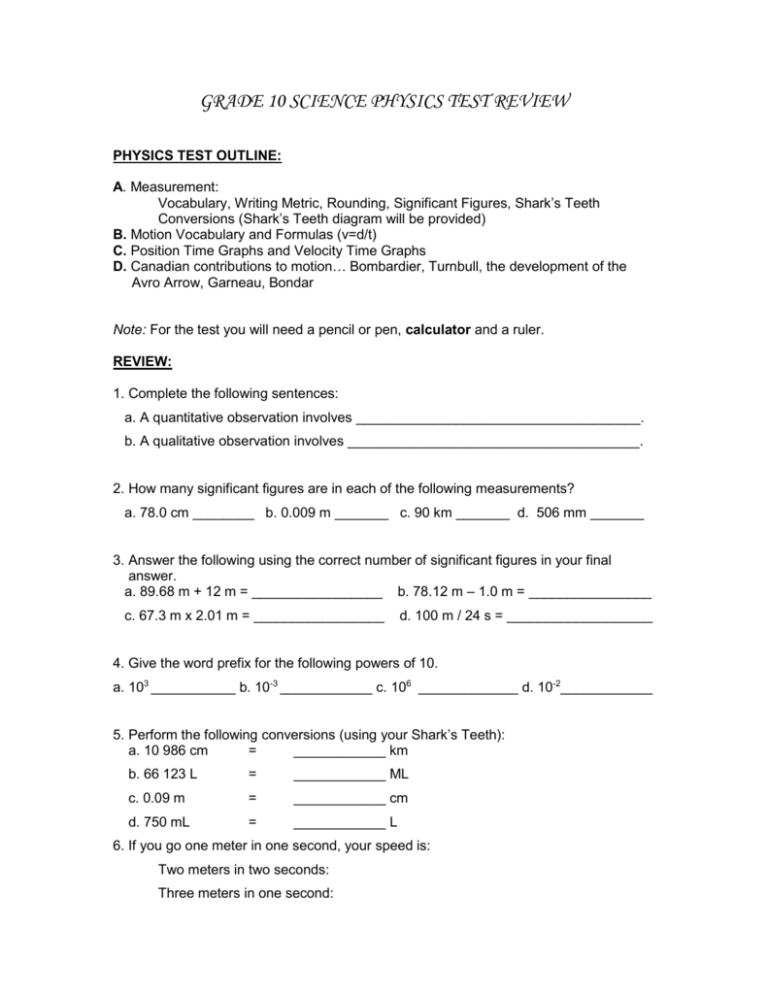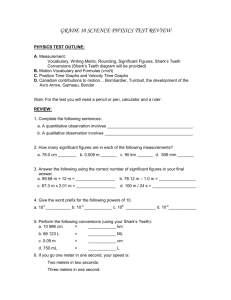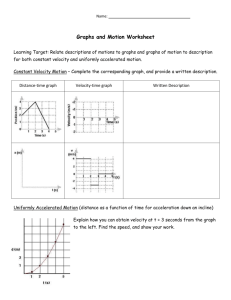Grade 10 Physics Test Review: Measurement & Motion
advertisement

GRADE 10 SCIENCE PHYSICS TEST REVIEW PHYSICS TEST OUTLINE: A. Measurement: Vocabulary, Writing Metric, Rounding, Significant Figures, Shark’s Teeth Conversions (Shark’s Teeth diagram will be provided) B. Motion Vocabulary and Formulas (v=d/t) C. Position Time Graphs and Velocity Time Graphs D. Canadian contributions to motion… Bombardier, Turnbull, the development of the Avro Arrow, Garneau, Bondar Note: For the test you will need a pencil or pen, calculator and a ruler. REVIEW: 1. Complete the following sentences: a. A quantitative observation involves _____________________________________. b. A qualitative observation involves ______________________________________. 2. How many significant figures are in each of the following measurements? a. 78.0 cm ________ b. 0.009 m _______ c. 90 km _______ d. 506 mm _______ 3. Answer the following using the correct number of significant figures in your final answer. a. 89.68 m + 12 m = _________________ b. 78.12 m – 1.0 m = ________________ c. 67.3 m x 2.01 m = _________________ d. 100 m / 24 s = ___________________ 4. Give the word prefix for the following powers of 10. a. 103 ___________ b. 10-3 ____________ c. 106 _____________ d. 10-2____________ 5. Perform the following conversions (using your Shark’s Teeth): a. 10 986 cm = ____________ km b. 66 123 L = ____________ ML c. 0.09 m = ____________ cm d. 750 mL = ____________ L 6. If you go one meter in one second, your speed is: Two meters in two seconds: Three meters in one second: 6. Complete the following table. Vocabulary Term Time Symbol Standard Units Vector or Scalar? Position Speed Velocity Your answers must have the correct number of significant figures (sf) and include units. 7. A sprinter completes the 100 m (exact measurement) race in 11.10 s. At what speed (m/s) was the sprinter running? 8. If a car is travelling at a speed of 95.0 km/h for 2.5 hours, how far has it travelled? 9. During a car trip, the car has an initial position of 2.14 km and a final position of 98.20 km. What is the car’s displacement? 10. Sarah went on a biking tour with her partner. For the first part of the trip they travelled at an average speed of 30 km/h for 2.0 hours. Then, for the next 2.0 hours, they travelled at an average speed of 25 km/h. What was their speed in m/s for the first part of the trip? The second part? If they took 3 hours to travel 103 km, would they be travelling faster or slower than the first two legs of their journey? 11. Do you know how to complete the following sentences? * Marc Garneau was the first Canadian to __________________________________. * Bombardier invented the ______________________________________________. * Turnbull changed the world of aviation when he invented the __________________. 12. Why was the Avro Arrow such a significant accomplishment in aviation history? What happened to it? 13. Compare and contrast the terms: A) velocity and speed B) displacement and distance C) kinetic and potential energy 14. Using the position time graph answer the The position of a person versus time. following questions: Position (m) 12 10 8 6 4 2 0 0 2 4 6 8 Time (s) a. b. c. d. e. f. 15. What is the initial position of the person? ___________________________ What is the final position of the person? ___________________________ What is the displacement of the person? ___________________________ What is the average velocity of the person? ___________________________ What is the equation of the line? (Remember: y= mx+b) _____________________ If the person continued to walk at this average velocity, how long would it take her to reach a position of 15 m? Sketch a velocity time graph to illustrate each of the following: A car sitting in a driveway, not moving. A car travelling forward at a constant speed of 40 km/h for the entire observation interval. 13. Describe the motion of the car in the following graphs: The velocity of a car versus time. The velocity of a car versus time. 20 15 10 5 0 -5 0 -10 1 2 3 4 5 6 Velocity (km/h) Velocity (km/h) 20 15 10 5 0 -5 0 -10 1 2 3 4 5 -15 -20 -15 -20 Time (h) Time (h) Final pretest words of wisdom: Be clear on your different graphs, slopes, velocities etc…extra review could involve exploring the Glenbrook website lessons done so far and going through the questions at the end of your Chapters 10 and 11… 6





